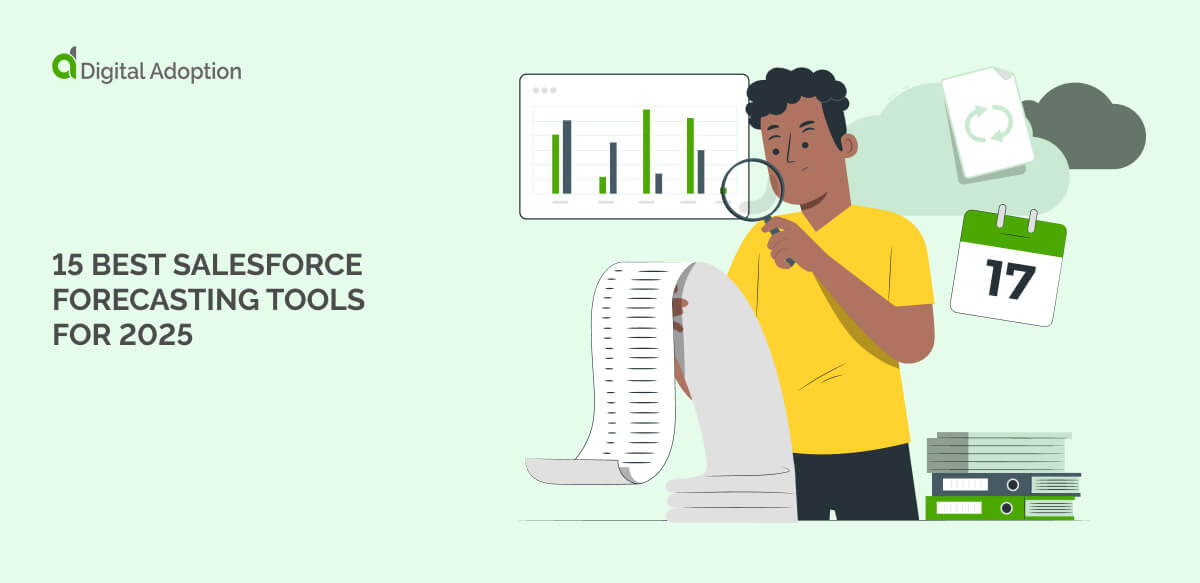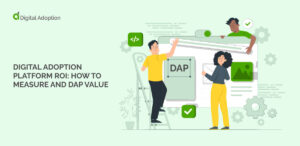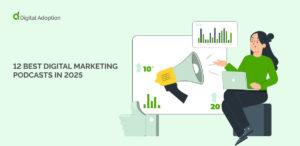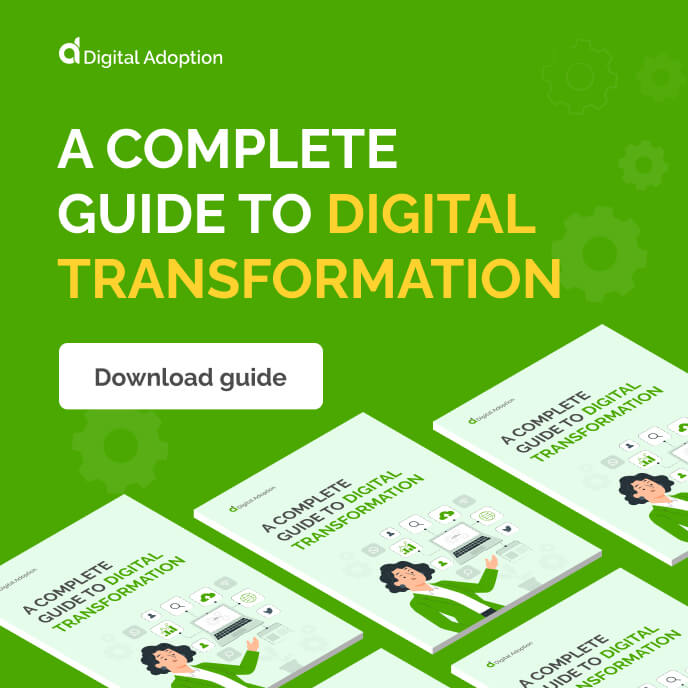Salesforce forecasting tools provide companies with a dynamic view of future performance, rooted in real-time sales data.
As the tech buying process stretches and markets shift faster than legacy CRMs can track, static forecasts break down. Today’s sales leaders need forecasting tools that combine real-time data and AI-driven insights to adapt quickly to pipeline volatility, rep behavior, and deal risk. Yet, four in five sales and finance leaders missed their quarterly forecasts at least once in the previous year.
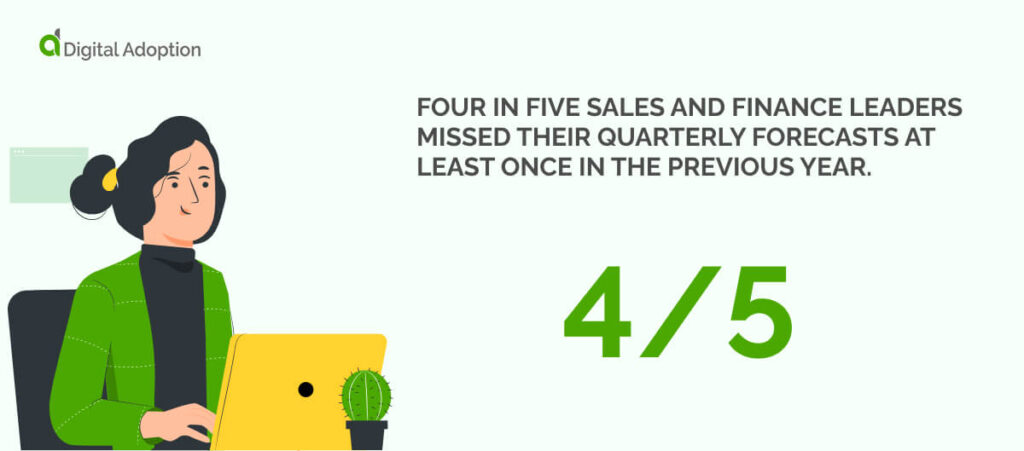
Salesforce embeds these capabilities directly into its platform, offering a single source of truth that links sales activity to revenue projections. This integration fuels Salesforce adoption among enterprises pursuing precision, speed, and accountability in forecasting.
This article examines fifteen Salesforce forecasting tools, highlighting how each enhances forecast accuracy, pipeline visibility, and sales delivery processes to help businesses convert data into actionable revenue predictions.
- Salesforce forecasting tools at a glance
- 1. Sales Cloud Dashboards (Sales Cloud)
- 2. AI Sales Forecasting (Sales Cloud) (AppExchange add-on)
- 3. Clari (AppExchange)
- 4. Revenue Grid
- 5. Aviso
- 6. Anaplan for Salesforce
- 7. Xactly Forecasting
- 8. Einstein Analytics (Tableau CRM)
- 9. Salesforce Manufacturing Cloud (Sales Cloud)
- 10. Insight Squared
- 11. People.ai
- 12. MuleSoft
- 13. EbstaTeams
- 14. Adaptive Planning by Workday
- 15. AppExchange (Not a tool, but offers tools for developer forecasting)
- How to choose the right Salesforce forecasting tool for your business?
- People Also Ask
Salesforce forecasting tools at a glance
| Tool | G2 Rating | Key Features |
| Sales Cloud Dashboards | 4.4/5 (23,362) | Real-time data visualization, Customizable metrics and KPIs, Interactive drill-downs |
| AI Sales Forecasting | 4.4/5 (23,362) | Predictive forecasting, Opportunity scoring, Trend analysis |
| Clari | 4.6/5 (5,461) | AI-driven deal predictions, End-to-end forecast views, Pipeline health tracking |
| Revenue Grid | 4.5/5 (512) | AI-guided pipeline insights, Real-time deal alerts, Automated forecast roll-ups |
| Aviso | 4.4/5 (826) | AI-driven deal scoring, Real-time forecast updates, Scenario planning |
| Anaplan for Salesforce | 4.6/5 (404) | Real-time Salesforce sync, Scenario modeling, Collaborative planning |
| Xactly Forecasting | 4.1/5 (129) | AI-powered deal risk detection, Multi-level forecasting, Salesforce integration |
| Einstein Analytics | 4.3/5 (408) | AI-powered predictions, Custom dashboards, Seamless integration |
| Salesforce Manufacturing Cloud | 4.4/5 (23,362) | Unified sales data, Account-based forecasting, Real-time visibility |
| Insight Squared | No rating | AI-powered forecast validation, Automated activity capture, Real-time coaching |
| People.ai | 4.4/5 (463) | AI-based activity tracking, Predictive deal scoring, Pipeline visibility tools |
| MuleSoft | 4.4/5 (701) | Real-time ERP integration, Bi-directional data flow, Scalable API architecture |
| EbstaTeams | 4.7/5 (48) | Forecast visibility, Detailed pipeline metrics, Native Salesforce sync |
| Adaptive Planning by Workday | 4.3/5 (275) | Driver-based forecasting, Scenario analysis, Pipeline integration |
| AppExchange | n/a | Wide selection, Native integration, Customizable tools |
1. Sales Cloud Dashboards (Sales Cloud)
- G2 rating: 4.4/5 (23,362 reviews)
Our first entry is Sales Cloud Dashboards, native to Salesforce’s ecosystem. Built into the platform, these dashboards provide sales teams with real-time visibility into pipeline metrics, including quota progress, deal stages, and shifting forecast trends. They also consolidate diverse data sources, eliminating fragmented views that hinder timely decisions.
Paired with the forecasting engine, these Salesforce dashboards transform raw, complex data into actionable insights. Tight integration ensures forecasting accuracy is embedded in everyday sales operations.
2. AI Sales Forecasting (Sales Cloud) (AppExchange add-on)
- G2 rating: 4.4/5 (23,362 reviews)
Our next tool is AI Sales Forecasting for Sales Cloud, available via AppExchange. This add-on applies machine learning (ML) to past performance, pipeline activity, and rep behavior to generate continuously updated forecasts.
It detects shifts early before they affect targets and flags deals at risk. Built to extend native Salesforce forecasting, it adds predictive depth without disrupting digital workflows. For sales teams managing uncertainty, it delivers fast, data-backed projections tailored to real selling patterns.
3. Clari (AppExchange)
- G2 rating: 4.6/5 (5,461 reviews)
Clari connects directly to Salesforce to provide a complete view of forecast health across teams, product lines, and periods. It utilizes activity data such as emails, meetings, and CRM inputs to track deal momentum and pipeline changes automatically.
Forecast rollups are no longer manual and are driven by real-time engagement signals. Clari also models upside, commit, and best-case scenarios side by side, helping revenue leaders course-correct early and align teams around numbers that really hold up.
4. Revenue Grid
- G2 rating: 4.5/5 (512 reviews)
Revenue Grid connects directly to Salesforce, turning sales activity into accurate, up-to-date forecasts. It tracks emails, meetings, and calls, then maps this data onto your pipeline to highlight risks and gaps.
What makes it stand out is its ability to suggest next steps directly within Salesforce, eliminating the need to switch tools or engage in guesswork. Leaders get a clear view without chasing reps for updates, while teams stay focused on deals that actually move the number.
5. Aviso
- G2 rating: 4.4/5 (826 reviews)
Aviso works with Salesforce to provide clear, up-to-date sales forecasts using advanced AI. It watches how deals move and spots hidden risks by looking at communications and pipeline activity.
The tool provides helpful suggestions, enabling sales reps to focus on the most important opportunities and identify deals that require attention. Easy-to-read reports keep leaders informed without extra work. Aviso is a good fit for teams that want simple, data-driven forecasting to support better sales decisions.
6. Anaplan for Salesforce
- G2 rating: 4.6/5 (404 reviews)
Anaplan for Salesforce combines sales and financial planning into one easy-to-use platform. It pulls data from Salesforce, allowing teams to build detailed forecasts using various “what-if” scenarios. This helps companies align sales goals with budgets and adjust quickly when markets change.
With tools that encourage teamwork, everyone stays updated with the same accurate information. This clear communication enables faster and smarter decisions to meet revenue targets.
7. Xactly Forecasting
- G2 rating: 4.1/5 (129 reviews)
Xactly Forecasting works with Salesforce to give accurate sales predictions based on past results and current deals. It shows simple reports that highlight how healthy the pipeline is and where forecasts might fall short.
Automating updates frees sales teams from manual tasks, allowing them to focus on closing deals. Xactly’s insights also help everyone stay on the same page and keep revenue goals on track, even when markets change.
8. Einstein Analytics (Tableau CRM)
- G2 rating: 4.3/5 (408 reviews)
Tableau CRM (formerly Einstein Analytics) works inside Salesforce to deliver smart sales forecasts with clear, easy-to-use visuals. It uses past data and real-time updates to spot trends and risks in your sales pipeline.
Sales teams can explore interactive dashboards to understand what’s driving forecasts and find bottlenecks fast. Bringing AI insights directly into daily workflows, Tableau CRM enables teams to make informed decisions that enhance forecast accuracy and drive revenue growth.
9. Salesforce Manufacturing Cloud (Sales Cloud)
- G2 rating: 4.4/5 (23,362 reviews)
Salesforce Manufacturing Cloud changes how manufacturers forecast by addressing their specific needs. It combines sales agreements with pipeline data, allowing teams to view both confirmed revenue and upcoming deals.
Built right into Salesforce, it links sales forecasts with supply chain and production plans. This helps manufacturers predict changes in demand and adjust quickly. Connecting sales and operations makes forecasts more reliable and easier to understand, reducing surprises and keeping everyone aligned.
10. Insight Squared
- G2 rating: No rating available
Our next entry is InsightSquared, a tool that works closely with Salesforce to improve sales forecasting. It utilizes AI to assess the likelihood of deals closing and determine if customers are a good fit.
Forecast updates occur automatically, and easy-to-read dashboards indicate where risks and opportunities lie. Tracking real sales activities, InsightSquared helps teams stay accountable and make smarter, clearer decisions about their sales forecasts.
11. People.ai
- G2 rating: 4.4/5 (463 reviews)
People.ai brings forecasting into focus by connecting Salesforce with real sales behavior. It automatically logs activities, such as emails, meetings, and calls, and links them to the relevant deals.
This provides teams with a comprehensive view of how engaged each account is. Instead of relying on guesswork, sales leaders see forecasts based on actual effort and buyer response, making planning clearer, more accurate, and easier to trust.
12. MuleSoft
- G2 rating: 4.4/5 (701 reviews)
MuleSoft helps Salesforce users build stronger forecasts by connecting data from across the business. It brings in real-time information from tools such as finance, inventory, and marketing systems, giving sales teams a comprehensive view beyond the CRM.
It means forecasts aren’t based on guesswork or missing data. Everything from supply to demand is visible in one place, making it easier for teams to plan ahead and make decisions they can stand behind.
13. EbstaTeams
- G2 rating: 4.7/5 (48 reviews)
Ebsta connects to Salesforce and tracks how often reps engage with buyers, such as the frequency of emails, meetings, or calls. It uses this data to indicate the strength of each deal and identify areas where attention is needed.
Forecasts update automatically, so teams don’t waste time chasing numbers. With clear, simple dashboards, sales leaders can coach more effectively, identify risks early, and focus on deals that are most likely to close.
14. Adaptive Planning by Workday
- G2 rating: 4.3/5 (275 reviews)
Adaptive Planning by Workday combines sales and business data for more informed planning. It enables teams to test different scenarios and understand potential sales outcomes. Using AI, it offers reliable forecasts and easy-to-read reports that everyone can follow.
The platform encourages collaboration by keeping all team members aligned. This approach turns forecasting from a guess into a clear, shared plan that adapts as conditions change.
15. AppExchange (Not a tool, but offers tools for developer forecasting)
AppExchange is not a forecasting tool but a marketplace full of apps designed to work with Salesforce. These apps enable developers to build custom forecasting solutions tailored to various business needs.
They offer easy-to-use tools for revenue predictions and pipeline tracking. We’ve decided to include AppExchange on our list of Salesforce forecasting tools because it provides a vast selection of ready-made apps that extend and customize forecasting capabilities.
How to choose the right Salesforce forecasting tool for your business?
Procurement, sales, and revenue teams face key questions when deciding to invest in forecasting tools.
Consider how easily the tool integrates with existing systems, whether sales reps can adopt it quickly with proper Salesforce training, and if leadership supports a data-driven approach.
Teams should ensure the tool fits into workflows, can grow with the business, and offers an intuitive experience that encourages regular use. Most importantly, it must deliver insights that guide decisions.
Selecting the right Salesforce forecasting tool means matching your business needs with available features and flexibility. Use our curated list to find options that suit your goals, whether you need live dashboards, AI predictions, or data flow.
The best tool turns uncertainty into clear confidence, strengthening your sales delivery processes and giving your sales efforts a real edge.
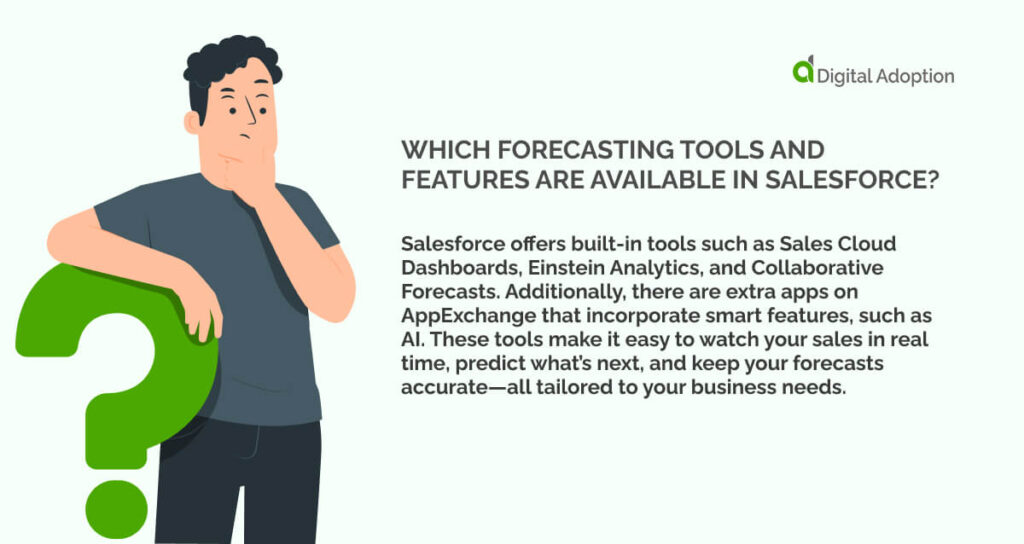
People Also Ask
-
What makes Salesforce forecasting a smart choice for your business?Salesforce forecasting gives you up-to-date insights into your future sales using real data from your team’s daily work. It fits naturally into your sales process, making it easier to use and trust. By bringing everything into one place, it helps everyone make faster, smarter decisions to keep your business on track, even when markets change.
-
How does Salesforce forecast and track sales performance?Salesforce gathers information from deals, stages, and sales activities to build ongoing forecasts. It shows progress toward goals with clear dashboards and reports, pointing out risks and opportunities early. The system updates automatically and uses AI to help sales leaders adjust plans quickly, improving accuracy and team results.
-
Which forecasting tools and features are available in Salesforce?Salesforce offers built-in tools such as Sales Cloud Dashboards, Einstein Analytics, and Collaborative Forecasts. Additionally, there are extra apps on AppExchange that incorporate smart features, such as AI. These tools make it easy to watch your sales in real time, predict what’s next, and keep your forecasts accurate—all tailored to your business needs.

